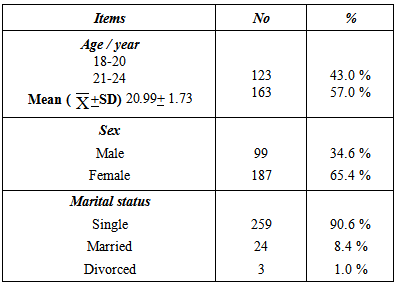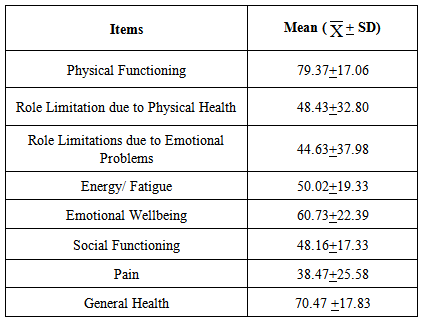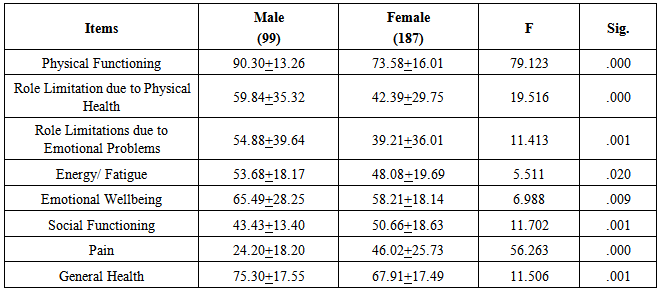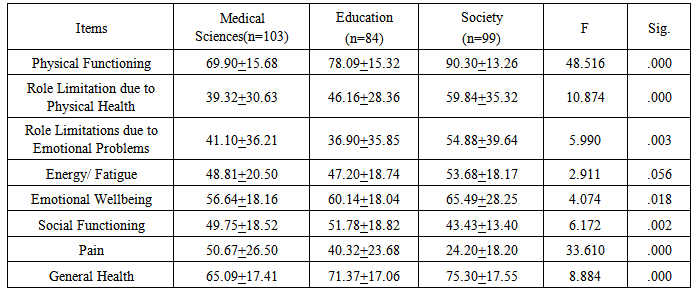-
Paper Information
- Paper Submission
-
Journal Information
- About This Journal
- Editorial Board
- Current Issue
- Archive
- Author Guidelines
- Contact Us
International Journal of Nursing Science
p-ISSN: 2167-7441 e-ISSN: 2167-745X
2014; 4(2): 22-25
doi:10.5923/j.nursing.20140402.02
Health-Related Quality of Life among Students at King Khalid University – Mohail Asser
Mona Mohamed Megahed
Nursing Department, College of applied medical sciences Mohaiel Asser, king Khalid University, Saudi Arabia
Correspondence to: Mona Mohamed Megahed, Nursing Department, College of applied medical sciences Mohaiel Asser, king Khalid University, Saudi Arabia.
| Email: |  |
Copyright © 2014 Scientific & Academic Publishing. All Rights Reserved.
Health-Related Quality of Life (HRQOL) is a broad multidimensional concept that typically encompasses self-reported measures of physical and mental health. HRQOL encompasses several domains to include functional ability, psychological state, social function, and an individual's perception of his or her health. Objective: Evaluate quality of life among university students and Compare differences of quality of life domains across males and females. Methods: A cross-sectional study design was conducted among randomly selected 286 Saudi students from both sexes. From December 2011 to March 2012 among students at community college, applied medical sciences college and education college, king Khalid University. Two tools were used for data collection named interview questionnaire sheet covered socio demographic data and MOS-SF 36 (version 1.0). Results: 57% of study sample aged 21-24 years, 65.4% were female students, and 90.6% were single, lowered mean scores in most of eight health domains among study sample. There is a significant difference between study sample sex, type of education and their eight heath domains. Conclusions: The study findings reflect poorer health related quality of life among study sample; female students had lower scores than male. More studies are recommended to explore factors affecting quality of life of university students especially in the medical field, and counseling programs that help them relieve stress and strains which impact in improve their physical and mental health.
Keywords: Health -Related Quality of Life, MOS-SF 36, University student
Cite this paper: Mona Mohamed Megahed, Health-Related Quality of Life among Students at King Khalid University – Mohail Asser, International Journal of Nursing Science, Vol. 4 No. 2, 2014, pp. 22-25. doi: 10.5923/j.nursing.20140402.02.
Article Outline
1. Introduction
- Quality of life is a popular term that conveys that overall sense of well-being, including aspects of happiness and satisfaction with life as a whole. It's abroad and subjective rather than specific and objective although health is an important domain of overall quality of life, there are other domains as well- instance: jobs, housing, schools, and the neighborhood. Aspects of culture, values, and spirituality are also key aspects of overall quality of life that add to the complexity of its measurement. [1]Since 1948, when the world health organization defined health as being not only the absence of disease and infirmity but also the presence of physical, mental and social wellbeing, quality of life issues have become steady more important. [2] moreover Quality of life was defined by WHO as the individual perception of his position in life, within the context of culture and system of values where the individual lives and in relation to his objectives, expectations, standards and concerns. [3]Health related quality of life (HRQOL) assessment has increasingly been acknowledged as valuable for decision making in clinical and community settings, it provides information about the functioning and wellbeing of population. [4] HRQOL is rapidly gaining acceptance as a measurable outcome. It’s a broad multidimensional concept that typically encompasses self –reported measures of functional ability, psychological state, social function, and individual perception of his/her health. [5]University life is stressful period in one's life that can result in lowered levels of HRQOL, common stressors among university students are academic pressure, peer pressure, being away from home. [6]University students are special population group regarding health issues. Their worries, concerns and burdens differ from other population groups, they are more susceptible to stress, burning out, depression, and anxiety. [7] There may be several factors affected them such as academic courses and training. [8]Studying the HRQOL among university students is very significant because their HRQoL not only affect them but also affect students' performances and good health produce good quality students. So the current study is conducted to evaluate quality of life among university students’, compare differences of quality of life domains across males and females and Identify factors affect quality of life.
2. Methodology
2.1. Research Design
- A cross-sectional study design was conducted From December 2011 to March 2012.
2.2. Study Setting and Subjects
- The study was conduct among Saudi students from both sexes at community college, applied medical sciences college and education college, king Khalid University. Inclusion criteria:§ Age: 18-25§ Gender: both§ Only Saudi students. § Willing to participate in the study.§ Exclusion criteria: § Any student with chronic disease.§ Handicapped students.§ On daily medication for any medical condition.§ Pregnant ladies.Total number of 305 was randomly selected from students name list. According to sample criteria 286 were the study sample.
2.3. Tools of Data Collection
- Tool (1): Interviewing questionnaire was used covered the following items (age, college, level, marital status, sex, chronic disease and taking daily medication).Tool (2): The medical outcome study "MOS-SF (version 1.0)" is the RAND 36-item health survey taps eight health concepts as the following; physical function, bodily pain, role limitation due to physical of health problems, role limitation due to personal or emotional problems, emotional well-being, social function, energy/fatigue and general health perception. The tool is reliable (Cronbach's alpha coefficient r = .742).Scoring: scoring procedure for MOS-SF 36 has been distributed by International Resource Center for health care assessment. In addition, each item is scored 0 to 100, a higher score indicating less limitation, better functioning or less pain (ware & sherbourne 1999, Hays & Shapiro 1992, and stewart et al 1992) [9, 10, 11].
2.4. Ethical Consideration
- An official permission with written letter clarifying purpose of the study was obtained from the dean of the colleges to conduct the field work of the study.
2.5. Statistical Method for Analysis
- Data entry inserted using SPSS statistical software packages. Data was presented using descriptive statistics in the form of frequencies and percentages for qualitative variables, and means and standard deviations for quantitative variables. Anova test used to compare between means.
3. Results
- Total number of study sample was 286 with mean age 20.99+ 1.73, 65.4% were females and majority of them (90.6%) were single. Table (1)
|
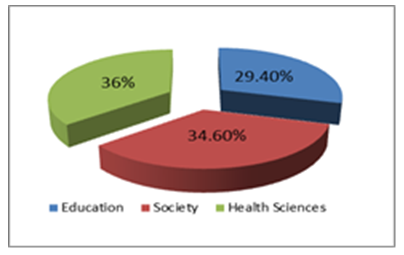 | Figure (1). Study sample type of education |
|
|
|
4. Discussion
- Quality of life is one's subjective perception of one's own well- being within one's socio cultural context. [12] HRQOL questions about perceived physical and mental health and function have become an important component of health surveillance and valid indicators of service needs and intervention outcomes. [13] HRQOL measures make it possible to demonstrate scientifically the impact of quality of life on health. [14]Our present study carried out to evaluate quality of life among university students', their mean age was 20.99+ 1.73, majority of them were females and single. The study results revealed poorer quality of life among study sample, mean score of physical health, role limitation due to emotional problems, energy/ fatigue, emotional wellbeing, social functioning and pain were lower scores, this finding was the same as study observed impairment in HRQL among medical students, [8] but other studies contracted with us. [15, 16, 17] Worse health- related quality of life was found among female university students. [18] In study carried out among university students to explore factors associated with health related quality of life several factors found to be associated with worse quality of life such as female sex and more frequent use of health – care services. [15] our results shown female students had lower mean scores in most of health domains than male students, this result was consistent with another study found gender influenced the quality of life, male students had significantly higher scores than female students. [19] Moreover female students experience more stress and more susceptible to negative stressful life events than men, theses negative perceptions of stressful life situations may interfere in female students' self – evaluation of their well- being. [8] however female students mean score higher than males in social function domain, studies shown that women are better than men in dealing with interactions. [20] students in medical field present higher levels of stress, responsibilities and academic pressure compared with other students of the same age in other programs that impact on student's health and quality of life. [21] In our study we found significant differences between type of education and HRQOL domains, medical applied health sciences students shown lower scores than other specialties in Physical functioning, physical health, emotional wellbeing and general health.
5. Conclusions
- Overall, the current study reflected poorer health related quality of life among study sample; female students had lower scores than male, especially applied medical health sciences students. University students in medical field need health measures and counseling programs that help them relieve stress and strains which impact in improve their physical and mental health.
ACKNOWLEDGMENTS
- The authors would like to thank all the students at the College of Medical Applied Sciences, Education College and Society College at King Khalid University, for their sincere cooperation.
 Abstract
Abstract Reference
Reference Full-Text PDF
Full-Text PDF Full-text HTML
Full-text HTML